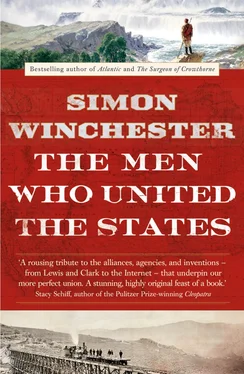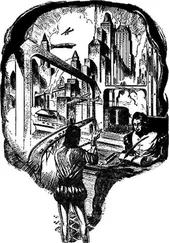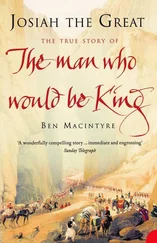What followed was an epiphany. After an initial bout of dithering—he was shrewdly wary of Owen’s eccentricities and shortcomings, even then—William Maclure finally and decisively bought into the revolutionary plans. He agreed. He would uproot himself from the comforts of his Pennsylvania life, move the eight hundred miles across and down to New Harmony, and throw in his lot with Owen’s strange new settlement.
Moreover, and more important still, he persuaded a number of his scientific colleagues to come along with him. They were a die-hard group, young men and women, also largely from Pennsylvania, who thought the idea of going off to live in Owen’s eccentric new commune was both worthy and noble. Most of those who volunteered were younger than Maclure. All were as eager as he was to teach youngsters the knowledge they had accrued. All were dreamy and impractical idealists.
So he made the journey a suitably impractical adventure. Rather than have the party travel down to Indiana in the comfort of the stagecoach, Maclure had them all go down on a boat. It was a shallow-draft keelboat, with barely room for forty, rowed by six oarsmen. Officially it was named the Philanthropist , but Owen proclaimed that “it contained more learning than ever was before contained in a boat,” so it was and still is informally known as the Boatload of Knowledge .
The vessel took off down the Ohio River from Pittsburgh on a bitter Sunday in late November 1825. After punching its way though the ice for the next seven weeks—its passengers listening to the onboard piano, taking off for skating ventures, reciting poetry and reading, reading—everyone arrived at New Harmony on a bitter cold day in late January. Fifty tons of books and what was termed “philosophic apparatus” joined them a few days later, whereupon the team promptly began—under the supervision of Maclure and Owen (who had come down at ease, on the stagecoach)—a hyperactive program of teaching to all and any of the youngsters from the towns nearby, just what they had to offer.
But there was more hyperactivity than most had bargained for. The furious energy of Owen’s New Harmony experiment barely survived Maclure’s arrival. The enthusiasm sputtered out within weeks, and the community soon began to fail, and it did so miserably and quickly. As is so often the way with utopias, factions developed—no fewer than ten had formed within just two years of Owen’s arrival, and all began bickering, squabbling, and arguing for various rewritings of the commune rules, each splinter group jostling for ideological supremacy. In the end, a demoralized and disillusioned Owen, shocked at a brand of waywardness he had never experienced back home among the Scots, returned to Britain. His confidence was sorely shaken: his ideas for the universal betterment of the working classes began slowly to evaporate, and he became steadily ever more marginalized and ridiculed a figure. 2
But William Maclure did not immediately leave New Harmony. He remained behind to use the community as a base to preach the benefits of science and science education—and most especially the value of geology, the science that had first anchored him to America.
And in that sole regard, New Harmony was to become in this fresh incarnation something of a success. Maclure saw to it that the leaders of the more quarrelsome factions were persuaded to leave, that houses were now bought and sold and rents were expected and paid, that new shops were opened, and that the vigor of commercial life replaced the rigor of communal life. A printing shop was set up, and produce from the gardens was sent down to be sold in New Orleans.
Most of all, Maclure began to plan and finance his revolutionary education system, preaching and then practicing in town his long-held beliefs in the gift of free education for the American working youth. He gave his superb personal library to the town and opened it for the benefit of all. The young scientists—botanists, physicians, geologists—who had come down with him on the Boatload of Knowledge were to be the first teachers in the schools that were opened, and soon students came from towns and villages both nearby and far away. The town began to flourish again, and soon began to win a reputation—which spread nationwide—as a center of educational excellence.
Members of the community began to write books: there would soon be definitive multivolume works on fish, insects, the shells of mollusks, and the trees of North America. There was a resident engraver and color printer in New Harmony, too—and finely wrought monographs soon began to appear for sale at nearby fairs and bookstalls.
But William Maclure was beginning to feel his age. The Indiana winters were settling their cold deep into his bones. He started to take off on southerly explorations, finding himself eventually in Mexico, declaring a liking for it and settling on a new ambition to create progressive schools there. By 1830, when he was sixty-seven, he decided finally to cut loose from the winter cold of Indiana and stay put in the soothing balms of Mexico. He would for a while continue to finance New Harmony, but now only from afar.
THE TAPESTRY OF UNDERNEATH
The presiding intellectual genius who then ran New Harmony in his place was Robert Owen’s youngest son, David Dale Owen. who would become one of America’s leading geologists and a key player in the surveying of the nation as it expanded all the way westward across to the Pacific. William Maclure certainly started it all and is revered as the father of American geology in consequence. David Dale Owen, apprenticed in New Harmony, set in train the practical tasks that proved necessary for finding out what America was made of. Maclure had the vision and led the way; Robert Owen’s son went the distance and did the work.
When David Dale Owen was born, in 1807, there had been almost no geological maps made of anywhere. That soon began to change very rapidly, in response partly to Maclure’s American map of 1809 but more to William Smith’s map of England and Wales published in London in 1815, which demonstrated decisively how a proper stratigraphic map should be made. Not for nothing is Smith’s cartographic achievement still regarded as “the map that changed the world.” His revolutionary idea of illustrating the rocks according to their relative ages allowed for extrapolation and prediction: armed with a Smith map one could forecast with some certainty where a plunging coal seam might lead or where iron or copper—or one day, oil—could be found deep below the surface. By the time David Dale Owen assumed control of New Harmony, such mapping was standard practice in Europe, and both the federal government and state governments soon saw a pressing need to bring America similarly into order.
The first regions to be properly and systematically examined were in the Eastern states. The capital of New York State, Albany, was mapped in 1820 by Amos Eaton, a blacksmith’s son who two years earlier had published a cross section of America from the Catskill Mountains through Massachusetts to Boston and the Atlantic Ocean—a thing of sinuous curves and colors, showing the rock layers rising and falling in great subterranean swoops of blue and yellow that perhaps owe more to art than to science.
The practical demands of commerce soon introduced more scientific rigor to the mapmakers’ efforts: in 1832, Massachusetts became the first state to be systematically surveyed for its invisible underneath. The driving force behind the design was nakedly mercantile, the state’s governor demanding that the survey show “valuable ores … quarries … coal and lime formations … for the advancement of domestic prosperity.” Such imperatives would soon produce a torrent of new surveys and maps, invaluable guides to an America that was by now quickly evolving into an overwhelmingly industrialized nation.
Читать дальше












